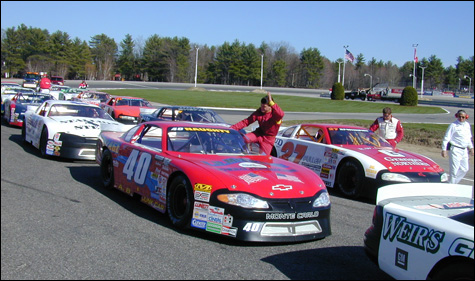
|
You may think the trees that ring the track at Beech Ridge Motor Speedway are an improbable background for a sports car race.
After all, leafy trees and clean air are not necessarily what come to mind when you think about race tracks. Cheering fans, maybe. Revving motors that sound like gravel going through a blender, sure. An ice-cold foamer, of course (if you’re legal!). But not hippies and tree-hugging. And yet Andy Cusack, the chief of our local speedway in Scarborough who orchestrated the planting of trees, grass, and flowers on the grounds, may be an unwitting trendsetter in the burgeoning movement in motor sports to go green.
Got any lingering doubts that environmentalism is becoming increasingly mainstream? If so, turn for proof to the wildly popular — and populist — sport of car racing. An improbable role model, you might say (and you’d be right). But anyone trying to get their minds around the complicated puzzles of greenhouse gases and global warming can learn a thing or two by watching how motor sports are adapting to the growing pressure to become eco-friendly.
It’s true that when worldwide carbon emissions hover around six billion tons a year, even the highest estimates of car-racing’s contribution to that are negligible (an inexact science puts those estimates anywhere between a couple hundred thousand tons to two million tons). But small amounts everywhere are what add up to a quickly dwindling supply of fossil fuels, and an increasingly damaged atmosphere.
Still, earnest entreaties don’t stand much of a chance in this arena. As the environmentally-friendly trend goes from 0 to 60 nationwide this racing season, racing fans and promoters alike may find themselves lured by practical incentives.
Zero to 160,000 (pounds)
Regardless of whether or not it’s deserved, racing’s bad environmental reputation is understandable. Unlike other professional sports, the entire sport revolves around an action that produces harmful emissions: driving a car.
Let’s start with NASCAR — after all, it’s is the second most-watched sport in America, after football. NASCAR race cars, like many of the ones driven at Beech Ridge, get between two and five miles per gallon of gasoline, and the average big NASCAR weekend, like those held at the New Hampshire International Speedway, guzzles up to 8000 gallons.
One gallon of gas equals 20 pounds of carbon dioxide, so that’s about 160,000 pounds of CO2 every weekend, 10 months of the year.
To put that in context, the average American’s combined activities and consumption creates between 40,000 and 50,000 pounds of CO2 per year. A drive from Portland to Boston and back would produce about 140 pounds of CO2. The energy used during the 2005 Super Bowl in Jacksonville contributed one million pounds of CO2 into the atmosphere. Still, if NASCAR emits 160,000 pounds in two days, that’s just 0.004 percent of our national two-day average, four billion pounds.
At two miles per gallon, open-wheel cars (the classic “race car” like those used in the Indianapolis 500 or Formula One, with wheels set out from the car’s body and a tiny cockpit sized for only one driver) aren’t any better in terms of fuel mileage. But they are far more responsible in terms of what type of fuel they use. For years, Indy Racing League cars ran on a mixture of ethanol — alcohol-based fuel (usually made from corn) that burns cleaner than petroleum-based gasoline — and methanol, another alternative fuel that is carbon-based but produces fewer emissions than gasoline. This season, for the first time, Indy cars are running 100 percent on ethanol.
More examples of environmental friendliness abound. Cars that race in the Champ Car Series run entirely on methanol. And Honda’s Formula One team is going all out this year to promote “My Earth Dream,” its 2007 race car that won’t carry any corporate-sponsor names — instead, it will display the (tiny) names of average racing fans who donate money toward Honda’s environmental charity. At the New Hampshire International Speedway, the largest track in the region that hosts actual NASCAR series events, several colleges just competed in designing, building, and racing hybrid sports cars.
Meanwhile, NASCAR — the most popular and best attended of all racing series — seems always to be behind the curve. They’re switching over this season from leaded fuel (which releases dangerous lead particles into the air and soil) to unleaded. That’s great news, but keep in mind that the rest of the country hasn’t used leaded fuel since 1996 — and most Americans started phasing it out in the 1980s.